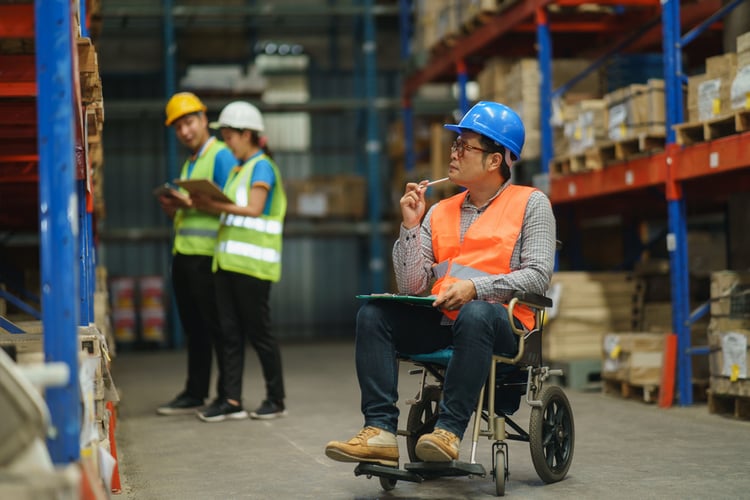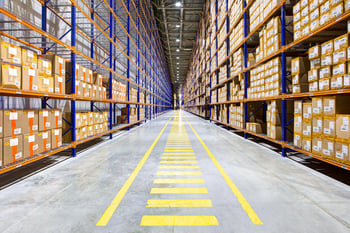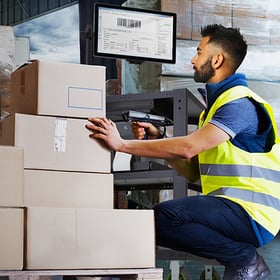
New and emerging technologies are elevating warehousing operations for everyone.
Some organizations are using these tools to improve access and make their
workplaces safer and more productive for workers who self-identify as disabled. In
many cases, this is even increasing job retention for a workplace experience that
benefits employers and their teams alike.
Ongoing Warehouse Labor Challenges
Amid historic eCommerce sales levels, the warehouse labor market is as tight as it has ever been. More warehouses and distribution centers are struggling to attract and retain talent, leading some companies to bring opportunities to a group that has been historically overlooked.
According to Cornell’s DisabilityStatistics.org, more than 11.5 million Americans with disabilities were unemployed yet actively looking for work in 2022. Leveraging technology to launch a disability inclusion program can help warehouses employ more workers and boost overall efficiency.
Warehouses Are Benefitting from Hiring Overlooked Talent
Warehouses and distribution centers nationwide are already benefiting from hiring disabled workers. James Emmett & Company, a consulting firm that works with large corporations like PepsiCo, Walgreens, Advance Auto Parts, and UPS, has helped more companies adopt inclusion labor strategies.
For example, Advance Auto Parts has been expanding its efforts to hire more workers with disabilities at its nationwide distribution centers. As of 2022, the company had hired more than 360 workers with autism or who are hard of hearing or deaf through the program.
According to disability inclusion consulting firm James Emmet & Company, some of the benefits of hiring this overlooked talent pool include:
- Greater performance, productivity, and workplace safety
- Enhanced brand loyalty and expanded customer base
- Lower turnover rates, including 48% greater tenure
- Potential federal and state financial incentives
- Higher worker return on investment
Leveraging Technology to Support Disabled Warehouse Workers
Warehouse jobs can be repetitive and even hazardous, which would understandably make a business question whether the work is suitable for people with disabilities. But the results prove these workers excel in these positions and even have lower turnover rates and better safety records than the non-disabled population.
If your warehouse wants to hire more disabled workers, leveraging warehouse automation solutions is the best way to make tasks even more suitable for these workers. Here are some ways your business can use different technology innovations to support disabled workers in a warehouse or distribution center environment.
Reconfigure Shelving
 It’s not uncommon for warehouses to struggle with inefficient design, meaning the layout of shelving or product storage isn’t optimized for maximum productivity. You can address this issue and make your warehouse more accessible by reconfiguring your shelving.
It’s not uncommon for warehouses to struggle with inefficient design, meaning the layout of shelving or product storage isn’t optimized for maximum productivity. You can address this issue and make your warehouse more accessible by reconfiguring your shelving.
Place the most frequently accessed products in the easiest places to reach, which would be shelves that don’t require workers to reach up or bend over. You can also use mobile shelves that adjust to meet workers according to their specific needs.
Keep Aisles Accessible
Many warehouses have begun reducing their aisle space to increase shelving for inventory. However, this strategy can result in facilities being less accessible for disabled workers. Also, wider aisles make the picking process easier in many instances.
By keeping aisles a bit wider, wheelchairs can pass through them. Also, any robotic solutions you use will have room to maneuver in addition to workers without creating a safety hazard.
Replace Warehouse Stairs
There’s nothing wrong with taking advantage of your warehouse’s vertical space. But you’ll want to consider how you’re going to access items you store on the highest shelves. Overall, stairways are not accessible to people with mobility problems. Fortunately, there are alternatives.
You may be able to replace some or all of your stairways with ramps, elevators, or lifts. These options allow workers and automation tools to access different levels faster and safer.
Offer Wheelchair-Friendly Transportation
 Warehouses can be massive spaces where employees are required to get from one end to the other just to start or end a shift. You can make your warehouse more accessible by reconfiguring some of your company vehicles so they are wheelchair-friendly.
Warehouses can be massive spaces where employees are required to get from one end to the other just to start or end a shift. You can make your warehouse more accessible by reconfiguring some of your company vehicles so they are wheelchair-friendly.
Just because a worker needs a wheelchair, that doesn’t mean they aren’t capable of operating heavy machinery. You can also outfit things like forklifts and other heavy equipment so they can be operated solely by hand.
Implement Robotic Automaton
Another way to improve warehouse accessibility for workers with disabilities is to leverage robotic automation solutions. Some tasks like picking and packing may be too physically demanding for these workers. Automating a portion of the tasks can make them safer and more efficient and open them up to a broader workforce.
One example of robotic automation solutions includes things like automated guided vehicles (AGVs), which can move items throughout the warehouse without requiring workers to do any heavy lifting. Robotic assist devices can minimize barriers for employees with mobility issues by reducing the distance employees must walk daily.
Use Mobile Workstations
 A typical warehouse worker walks several miles per day on average, going back and forth to pick products, store inventory, or collect instructions from a central data location. This is a lot to ask of any employee, much less those with physical limitations.
A typical warehouse worker walks several miles per day on average, going back and forth to pick products, store inventory, or collect instructions from a central data location. This is a lot to ask of any employee, much less those with physical limitations.
Using mobile workstations in your warehouse can make these jobs more efficient and attractive to workers of every shape, size, and background. These are versatile tools that employees can use anywhere in the warehouse to get instructions or record activities.
Enable Multiple Picking Options
Picking is one of the most time-consuming and inefficient processes in a warehouse. It’s also one of the most inaccessible for disabled workers. However, the right processes and technology solutions can make it more accessible.
One way you can address this issue is by enabling multiple picking options. For example, pick-to-light systems, where a worker is visually guided to products, would be ideal for employees with hearing disabilities. And voice picking systems are another option for workers with other limitations.
The Bureau of Labor Statistics has reported that people with disabilities were less likely to be employed than those without disabilities. However, technology innovations in warehousing have created many employment opportunities for these diverse populations. By investing in these technologies, businesses are creating jobs for a stable and productive talent pool as well as paving the way for a more inclusive workplace.

